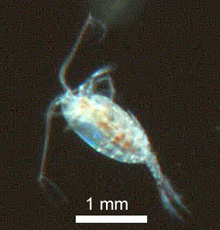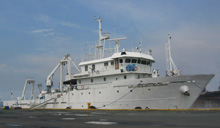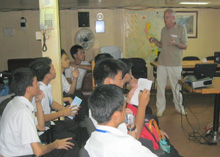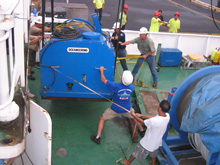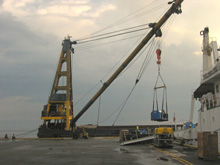The BRP Hydrographer Presbitero, chartered for our expedition, is shown here at dock in the Port of Manila. (BRP is the acronym for Barko ng Republika ng Pilipinas, which identifies it as a ship of the Republic of the Philippines.) The ship is used for various types of marine research, but she is specifically charged with producing data that can be used to create navigational charts and topographic maps. Click image for larger view and image credit.
Chief Scientist Larry Madin explains to high school students why it is important to study the deep-sea basin in the Celebes Sea. Click image for larger view and image credit.
Preparing for Departure
September 27, 2007
Peggy Hamner
Staff Research Associate and Co-director, COSEE-West
University of California, Los Angeles
"Look! The Customs officer has opened the containers!”
In response to this alarming exclamation, we all looked out the right-hand windows as our van turned into the Port in Manila Harbor. We had hoped that our research cruise would begin today, but there was a delay in moving our two 40-foot shipping containers through Philippine Customs, and they were not trucked to the port until yesterday afternoon. One container, shipped from the Woods Hole Oceanographic Institution (WHOI), held scientific sampling and diving equipment. The second container brought the Global Explorer remotely operated vehicle (ROV) and all of its accessories from Dutch Harbor in the Aleutian Islands, Alaska, where it had just been deployed in a successful search for the Grunion, a U.S. submarine that was sunk in World War II.
At the dock we saw the BRP Hydrographer Presbitero. (BRP is the acronym for Barko ng Republika ng Pilipinas, which identifies it as a ship of the Republic of the Philippines.) The ship had been chartered for our expedition by the National Mapping and Resource Information Agency (NAMRIA). Built in 1998, the 53-meter-long ship conducts submarine topographic and geophysical surveys and supports marine scientific research. She’ll be home for the next three weeks to 19 U.S. scientists, ROV pilots, technicians, and photographers; one representative of the U.S. Embassy in Manila; 7 Filipino scientists; 25 ship’s crew members; 3 catering staff; 1 medical officer from the Philippine Coast Guard; and 4 security personnel on loan from the Philippine Navy (in case we encounter pirates or terrorists in the southern Philippines).
We climbed up the gangplank to stow personal belongings in our assigned cabins, then watched forklifts slowly transfer the containers’ contents to the dock beside the ship. Most of the scientific gear could be lifted aboard by the ship’s crane, but a much bigger, stronger crane, mounted on a barge, was required to lift the ROV and its six-ton winch and place it on board. That maneuver demanded great skill by the crane operators and the ROV crew, who manhandled the winch into position as it was lowered onto the stern deck. The barge was tied off at the end of our dock, perpendicular to the Hydrographer Presbitero, and it rolled sideways with the gentle swells moving through the harbor. Just when the ROV crew would position the winch over the exact spot on the deck where they wanted it, the barge and crane would roll, swinging the winch out of position. Finally, they got the ROV winch set down on the deck, and at six tons, that spot is exactly where it will stay!
The six-ton winch hangs suspended just above the stern deck. Cruise members hold the long straps attached to the winch, attempting to maneuver it to the spot where they want it to sit. On the first several tries, the barge rolled just as the winch was set down, and it landed on the hatch cover in the foreground, behind Erich Horgan’s foot. Click image for larger view and image credit.
The barge-mounted crane lowers the six-ton winch down to the stern deck of the Hydrographer Presbitero. The yellow Global Explorer ROV sits on the dock in front of the gangplank, awaiting its turn to be lifted onto the ship. Click image for larger view and image credit.
While our group began unpacking and sorting their gear in the lab rooms, 60 high school students arrived to tour the ship and learn about our cruise to the Celebes Sea. The students were from Manila Science High School and the Philippine Science High School, schools that emphasize science courses, much like science magnet schools in the U.S. The ship’s officers explained how they carry out hydrographic and mapping surveys and showed the students various types of charts and maps produced from data collected on the ship.
The students gathered in the ship’s galley to watch a video describing the activities carried out by NAMRIA. Larry Madin, our chief scientist, then talked about why we want to investigate the deep basin of the Celebes Sea and showed the students photographs of the kinds of animals we hope to find on our expedition. We showed them our Ocean Explorer Web site and encouraged the students to e-mail us their questions. I hope they do!
We probably need two more days at the dock to make sure that the ROV is working and everything is ready to go. Our research site is a two-and-a-half-day voyage from Manila, so we can’t turn around to pick up something that we forgot! We will post logs every third day, using our Iridium satellite phone. I hope our next communication will tell you that we are on our way to the Celebes Sea!
Sign up for the Ocean Explorer E-mail Update List.





















